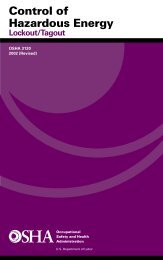Toxic Chemical Release Inventory Reporting Forms and Instructions
Toxic Chemical Release Inventory Reporting Forms and Instructions
Toxic Chemical Release Inventory Reporting Forms and Instructions
You also want an ePaper? Increase the reach of your titles
YUMPU automatically turns print PDFs into web optimized ePapers that Google loves.
Facility Eligibility Determination for Submitting an EPCRA Section 313 Report<br />
individual establishments may report releases <strong>and</strong> other waste<br />
management activities separately, provided that the total<br />
releases <strong>and</strong> other waste management quantities for the whole<br />
facility are represented by the sum of the releases <strong>and</strong> other<br />
quantities managed as waste reported by each of the separate<br />
establishments <strong>and</strong> the compliance determination is based on<br />
the entire facility.<br />
B.2.b. Auxiliary Facilities<br />
An auxiliary facility is one that supports another covered<br />
establishment’s activities (e.g., research <strong>and</strong> development<br />
laboratories, warehouses, <strong>and</strong> storage facilities). An auxiliary<br />
facility can assume the SIC code of another covered<br />
establishment if its primary function is to service that other<br />
covered establishment’s operations. For the purposes of<br />
EPCRA section 313, auxiliary facility is defined as one<br />
primarily engaged in performing support services for another<br />
covered establishment or multiple establishments of a covered<br />
facility <strong>and</strong> is in a different physical location than the primary<br />
facility. In addition, an auxiliary facility performs an integral<br />
role in the primary facility’s activities. In general, an auxiliary<br />
facility’s basic administrative services (paperwork, payroll,<br />
employment) are performed by the primary facility. Thus, a<br />
separate warehouse facility (i.e., one not located within the<br />
physical boundaries of a covered facility) may become a<br />
covered facility because it services a covered establishment in<br />
SIC codes 10 (except 1011, 1081, <strong>and</strong> 1094), 12 (except 1241),<br />
20–39, 4911 (limited to facilities that combust coal <strong>and</strong>/or oil<br />
for the purpose of generating electricity for distribution in<br />
commerce), 4931 (limited to facilities that combust coal <strong>and</strong>/or<br />
oil for the purpose of generating electricity for distribution in<br />
commerce), 4939 (limited to facilities that combust coal <strong>and</strong>/or<br />
oil for the purpose of generating electricity for distribution in<br />
commerce), 4953 (limited to facilities regulated under the<br />
RCRA Subtitle C, 42 U.S.C. section 6921 et seq.), 5169, 5171,<br />
<strong>and</strong> 7389 (limited to facilities primarily engaged in solvents<br />
recovery services on a contract or fee basis). Auxiliary facilities<br />
that are in these aforementioned codes are required to report if<br />
they meet the employee criterion <strong>and</strong> reporting thresholds for<br />
manufacture, process, or otherwise use.<br />
B.2.c. Property Owners<br />
You are not required to report if you merely own real estate on<br />
which a facility covered by this rule is located; that is, you have<br />
no other business interest in the operation of that facility (e.g.,<br />
your company owns an industrial park). The operator of that<br />
facility, however, is subject to reporting requirements.<br />
B.3 Activity Determination<br />
B.3.a. Definitions of “Manufacture,” “Process,”<br />
<strong>and</strong> “Otherwise Use”<br />
Manufacture: The term “manufacture” means to produce,<br />
prepare, compound, or import an EPCRA section 313 chemical.<br />
(See Part II, Section 3.1 of these instructions for further<br />
clarification.)<br />
Import is defined as causing the EPCRA section 313 chemical<br />
to be imported into the customs territory of the United States.<br />
If you order an EPCRA section 313 chemical (or a mixture<br />
containing the chemical) from a foreign supplier, then you have<br />
imported the chemical when that shipment arrives at your<br />
facility directly from a source outside of the United States. By<br />
ordering the chemical, you have “caused it to be imported,”<br />
even though you may have used an import brokerage firm as an<br />
agent to obtain the EPCRA section 313 chemical.<br />
Do Not Overlook Coincidental Manufacture<br />
The term manufacture also includes coincidental production of<br />
an EPCRA section 313 chemical (e.g., as a byproduct or<br />
impurity) as a result of the manufacture, processing, otherwise<br />
use or disposal of another chemical or mixture of chemicals. In<br />
the case of coincidental production of an impurity (i.e., an<br />
EPCRA section 313 chemical that remains in the product that<br />
is distributed in commerce), the de minimis exemption,<br />
discussed in Section B.3.c of these instructions, applies. The de<br />
minimis exemption does not apply to byproducts (e.g., an<br />
EPCRA section 313 chemical that is separated from a process<br />
stream <strong>and</strong> further processed or disposed). Certain EPCRA<br />
section 313 chemicals may be manufactured as a result of<br />
wastewater treatment or other treatment processes. For<br />
example, neutralization of wastewater containing nitric acid can<br />
result in the coincidental manufacture of a nitrate compound<br />
(solution), reportable as a member of the nitrate compounds<br />
category.<br />
Process: The term “process” means the preparation of a listed<br />
EPCRA section 313 chemical, after its manufacture, for<br />
distribution in commerce. Processing is usually the<br />
incorporation of an EPCRA section 313 chemical into a product<br />
(see Part II, Section 3.2 of these instructions for further<br />
clarification), however, a facility may process an impurity that<br />
already exists in a raw material by distributing that impurity in<br />
commerce. Processing includes preparation of the EPCRA<br />
section 313 chemicals in the same physical state or chemical<br />
form as that received by your facility, or preparation that<br />
produces a change in physical state or chemical form. The term<br />
also applies to the processing of a mixture or other trade name<br />
product (see Section B.4.b of these instructions) that contains a<br />
listed EPCRA section 313 chemical as one component.<br />
12 <strong>Toxic</strong>s <strong>Release</strong> <strong>Inventory</strong> <strong>Reporting</strong> <strong>Forms</strong> <strong>and</strong> <strong>Instructions</strong>
















